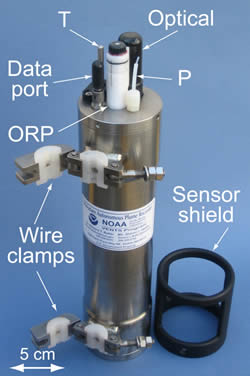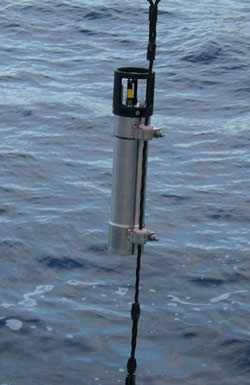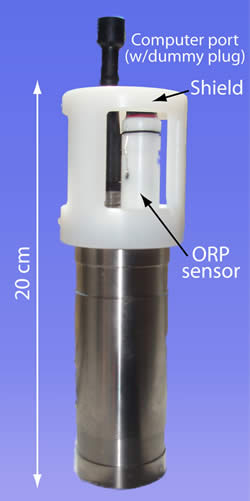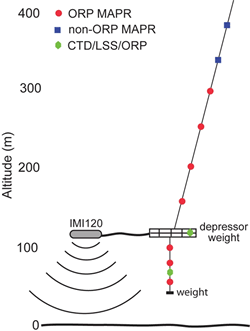Global Exploration
Miniature Autonomous Plume Recorders (MAPR)
Description
The PMEL MAPR is an inexpensive, lightweight yet rugged, simple to use self-contained instrument for recording light-backscattering (for suspended particle concentrations), oxidation-reduction potential (ORP, for detecting the presence of reduced chemical species such as H2S and Fe+2), temperature, and pressure during a wide variety of seagoing operations. MAPRs especially target operations where hydrothermal plume data are not normally collected: rock cores, dredges, or deep-towed geophysical and bottom imaging are some examples. To make these operations multi-disciplinary requires an instrument that is sensitive enough to detect hydrothermal optical anomalies yet simple enough for untrained researchers to use as an ancillary program without detracting from the time or efforts of the main sampling programs. With such an instrument, the opportunities to collect hydrothermal plume data through collaborations with other researchers, and without the need for additional dedicated technicians, expand to the global ocean.
The MAPR design allows it to be easily attached to many types of wire or towed instrument packages. Their small size makes them easy to handle and less likely to interfere with other instruments or wire configurations. Supporting software provides a point-and-click user interface for instrument configuration and data recovery that assures MAPRs are reliable and simple to use. Since their introduction in 1996, PMEL MAPRs have been successfully deployed by both PMEL and non-PMEL researchers at many locations not previously sampled for hydrothermal plumes. MAPRs are used both on vertical profile stations (e.g., rock cores) and in conjunction with deep-towed instrument packages (e.g., sonar mapping systems).
MAPR cases are 8.1-cm diameter 6A1-4V titanium tubes bored from rod with screwed end caps. Cable clamps welded to the tube are capable of accommodating various types and sizes of wire by using split polyethylene spool fillers of 0.6 to 2 cm diameter fixed within the clamp jaws to provide a secure clamping surface. These spools have been used on both conducting and fiber optic cables without damage. Alternatively, the MAPR case can be secured directly to the framework of an instrument package or submersible. Total length, including the guard covering the end cap sensors, is 41 cm; weight is 2 kg in water.
Through 2017, investigators from some 40 institutions (representing the USA and 11 foreign countries) have used MAPRs in more than 140 separate projects. Over 2500 water column MAPR profiles have been collected from every ocean basin. Over half the 600+ known vent sites listed in the global InterRidge Vents Database have been discovered using MAPRs.
We now also have available stand-alone ORP sensors designed for use with Sea Bird CTDs, ROVs, AUVs, and other instruments where a MAPR is not necessary. ORP sensors are especially useful in hunting for hydrothermal sites with ROVs and AUVs near the seafloor, where light-scattering anomalies can be confusing (e.g., sediment resuspension). Because the ORP signal, unlike light-scattering, degrades quickly in ambient water it is very sensitive to distance from an active source.
Both instruments can be used to 6000 m.
MAPR availability to the worldwide research community
MAPRs form the basis of a collaborative science program, rather than being a service or rental operation. We expect to be scientific partners, providing everything from technical assistance with the MAPRs, to quality control on the collected data, to participating in writing research papers in whatever role seems appropriate. We expect to receive a copy of the data when you return the MAPRs, to add to our worldwide database and to confirm that the instruments are operating properly. Of course we do not share the data with anyone without permission of the lead researcher.
The MAPRs program is self-sustaining and can only be kept available by our request for a user fee (by cruise or month) to defer maintenance costs, spare parts, upgrades, damages, instrument loss, etc. We supply everything you need (except a computer), including operating software, spare parts kit, tools, batteries, etc. Normally PMEL pays to ship MAPRs to the user and the user pays to ship back. We have a standard Memorandum of Understanding that PMEL and the user sign. This short and general MOU is the only way PMEL can accept funds. Because it is a legal document individual changes to the MOU are difficult.
Please contact Sharon Walker (sharon.l.walker@noaa.gov) or Edward Baker (edward.baker@noaa.gov) if you have an interest in using MAPRs or ORP sensors.
If you are interested in more details about MAPRs, blueprints for the MAPR pressure case and internal hardware, and schematic drawings for the MAPR circuit board and sensor board, are available in the accompanying engineering drawings (pdf files). We caution that constructing a reliable MAPR is expensive and time consuming and very unlikely to be economically worthwhile for an individual user. A list of publications that include MAPR results is given below.
MAPR References:
Pak, S.-J., J.-W. Moon, J. Kim, M.T. Chandler, H.-S. Kim, J. Son, S.-K. Son, S.K. Choi, and E.T. Baker (2017): Widespread tectonic extension at the Central Indian Ridge between 8°S and 18°S. Gondwana Res., 45, 163–179, doi: 10.1016/j.gr.2016.12.015, Available online.
Baker, E.T., S.L. Walker, J.A. Resing, W.W. Chadwick, Jr., S.G. Merle, M.O. Anderson, D.A. Butterfield, N.J. Buck, and S. Michael (2017): The effect of arc proximity on hydrothermal activity along spreading centers: New evidence from the Mariana back-arc (12.7°–18.3°N). Geochem. Geophys. Geosyst., 18(11), 4211–4228, doi: 10.1002/2017GC007234.
Baker, E.T. (2017): Exploring the ocean for hydrothermal venting: New techniques, new discoveries, new insights. Ore Geol. Rev., 86, 55–69, doi: 10.1016/j.oregeorev.2017.02.006, Available online.
Santana-Casiano, J.M., E. Fraile-Nuez, M. González-Dávila, E.T. Baker, J.A. Resing, and S.L. Walker (2016): Significant discharge of CO2 from hydrothermalism associated with the submarine volcano of El Hierro Island. Scientific Reports, 6, 25686, doi: 10.1038/srep25686, Published online.
Baker, E.T., J.A. Resing, R.M. Haymon, V. Tunnicliffe, J.W. Lavelle, F. Martinez, V. Ferrini, S.L. Walker, and K. Nakamura (2016): How many vent fields? New estimates of vent field populations on ocean ridges from precise mapping of hydrothermal discharge locations. Earth Planet. Sci. Lett., 449, 186-196, doi: 10.1016/j.epsl.2016.05.031.
Hahm, D., E.T. Baker, T.S. Rhee, Y.-J. Won, J.A. Resing, J.E. Lupton, W.-K. Lee, M. Kim, and S.-H. Park (2015): First hydrothermal discoveries on the Australian-Antarctic Ridge: Discharge sites, plume chemistry, and vent organisms. Geochem. Geophys. Geosyst., 16(9), 3061–3075, doi: 10.1002/2015GC005926.
Dziak, R.P., D.R. Bohnenstiehl, E.T. Baker, H. Matsumoto, J. Caplan-Auerbach, R.W. Embley, S.G. Merle, S.L. Walker, T.-K. Lau, and W.W. Chadwick, Jr. (2015): Long-term explosive degassing and debris flow activity at West Mata submarine volcano. Geophys. Res. Lett., 42(5), 1480–1487, doi: 10.1002/2014GL062603.
You, O.-R., S.K Son, E.T. Baker, J. Son, M.J. Kim, M.J. Barcelona, and M. Kim (2014): Bathymetric influence on dissolved methane in hydrothermal plumes revealed by concentration and stable carbon isotope measurements at newly discovered venting sites on the Central Indian Ridge (11–13°S). Deep-Sea Res. I, 91, 17–26, doi: 10.1016/j.dsr.2014.05.011.
Son, J., S.-J. Pak, J. Kim, E.T. Baker, O.-R. You, S-K Son, and J.-W. Moon (2014): Tectonic and magmatic control of hydrothermal activity along the slow-spreading Central Indian Ridge, 8°–17°S. Geochem. Geophys. Geosyst., 15(5), 2011–2020, doi: 10.1002/2013GC005206.
Baker, E.T., C. Hémond, A. Briais, M. Maia, D.S. Scheirer, S.L. Walker, T. Wang, and Y.J. Chen (2014): Correlated patterns in hydrothermal plume distribution and apparent magmatic budget along 2500 km of the Southeast Indian Ridge. Geochem. Geophys. Geosyst., 15(8), 3198–3211, doi: 10.1002/2014GC005344.
Baker, E.T., S.L. Walker, R.W. Embley, and C.E.J. de Ronde (2012): High-resolution hydrothermal mapping of Brothers caldera, Kermadec arc. Econ. Geol., 107, 1583–1593 (Society of Economic Geologists, 7811 Shaffer Parkway, Littleton, CO 80127 USA), doi: 10.2113/econgeo.107.8.1583.
Dziak, R.P., E.T. Baker, A.M. Shaw, D.R. Bohnenstiehl, W.W. Chadwick, Jr., J.H. Haxel, H. Matsumoto, and S.L. Walker (2012): Flux measurements of explosive degassing using a year-long hydroacoustic record at an erupting submarine volcano. Geochem. Geophys. Geosyst., 13, Q0AF07, doi: 10.1029/2012GC004211.
Laurila, T.E., S. Petersen, C.W. Devey, E.T. Baker, N. Augustin, and M.D. Hannington (2012): Tectonic and magmatic controls on hydrothermal activity in the Woodlark Basin. Geochem. Geophys. Geosyst., 13(9), Q09006, doi: 10.1029/2012GC004247.
Ray, D., K.A. Kamesh Raju, E.T. Baker, A. Srinivas Rao, A.V. Mudholkar, J.E. Lupton, L. Surya Prakash, R.B. Gawas, and T. Vijaya Kumar (2012): Hydrothermal plumes over the Carlsberg Ridge, Indian Ocean. Geochem. Geophys. Geosyst., 13, Q01009, doi: 10.1029/2011GC003888.
Baker, E.T., J.E. Lupton, J.A. Resing, T. Baumberger, M.D. Lilley, S.L. Walker, and K.H. Rubin (2011): Unique event plumes from a 2008 eruption on the Northeast Lau Spreading Center. Geochem. Geophys. Geosyst., 12, Q0AF02, 21 pp, doi: 10.1029/2011GC003725.
Baker, E.T., F. Martinez, J.A. Resing, S.L. Walker, N. Buck, and M.H. Edwards (2010): Hydrothermal cooling along the Eastern Lau Spreading Center: No evidence for discharge beyond the neovolcanic zone. Geochem. Geophys. Geosyst., 11, Q08004, doi: 10.1029/2010GC003106.
Marbler, H., A. Koschinsky, T. Pape, R. Seifert, S. Weber, E.T. Baker, L.M. de Carvalho, and K. Schmidt (2010): Geochemical and physical structure of the hydrothermal plume at the ultramafic-hosted Logatchev hydrothermal field at 14°45'N on the Mid-Atlantic Ridge. Mar. Geol., 271(3–4), 187–197.
Walter, M., C. Mertens, U. Stöber, C.R. German, D. Yoerger, J. Sültenfuß, M. Rhein, B. Melchert, and E.T. Baker (2010): Rapid dispersal of a hydrothermal plume by turbulent mixing. Deep-Sea Res. I, 57(8), 931–945.
Baker, E.T., R.M. Haymon, J.A. Resing, S.M. White, S.L. Walker, K.C. Macdonald, and K. Nakamura (2008): High-resolution surveys along the hot spot-affected Galápagos Spreading Center: 1. Distribution of hydrothermal activity. Geochem. Geophys. Geosyst., 9(9), Q09003, doi: 10.1029/2008GC002028.
German, C.R., S.A. Bennett, D.P. Connelly, A.J. Evans, B.J. Murton, L.M. Parson, R.D. Prien, E. Ramirez-Llodra, M. Jakuba, T.M. Shank, D.R. Yoerger, E.T. Baker, S.L. Walker, and K. Nakamura (2008): Hydrothermal activity on the southern Mid-Atlantic Ridge: Tectonically- and volcanically-controlled venting at 4–5°S. Earth Planet. Sci. Lett., 273(3–4), 332-344.
Melchert, B., C.W. Devey, C.R. German, K.S. Lackschewitz, R. Seifert, M. Walter, C. Mertens, D.R. Yoerger, E.T. Baker, H. Paulick, and K. Nakamura (2008): First evidence for high-temperature off-axis venting of deep crustal/mantle heat: The Nibelungen Hydrothermal Field, Southern Mid-Atlantic Ridge. Earth Planet. Sci. Lett., 275(1–2), 61–69.
Haymon, R.M., E.T. Baker, J.A. Resing, S.M. White, K.C. Macdonald, and GalAPA
GoS Team (2007): Hunting for hydrothermal vents along the Galapagos spreading center. Oceanography, 20(4), 100–107.
German, C.R., E.T. Baker, D.P. Connelly, J.E. Lupton, J. Resing, R.D. Prien, S.L. Walker, H.N. Edmonds, and C.H. Langmuir (2006): Hydrothermal exploration of the Fonualei Rift and Spreading Center and the North East Lau Spreading Center. Geochem. Geophys. Geosyst., 7, Q11022, doi: 10.1029/2006GC001324.
Murton, B.J., E.T. Baker, C.M. Sands, and C.R. German (2006): Detection of an unusually large hydrothermal event plume above the slow-spreading Carlsberg Ridge: NW Indian Ocean. Geophys. Res. Lett., 33, L10608, doi: 10.1029/2006GL026048.
Tolstoy, M., J.P. Cowen, E.T. Baker, D.J. Fornari, K.H. Rubin, T.M. Shank,
F. Waldhauser, D.R. Bohnenstiehl, D.W. Forsyth, R.C. Holmes, B. Love, M.R. Perfit, R.T. Weekly, S.A. Soule, B. Glazer, Science Party RV New Horizon, and Science Party RV Knorr (2006): A seafloor spreading event captured by seismometers. Science, 314(5807), 1920–1922.
Staudigel, H., S.R. Hart, A. Pile, B.E. Bailey, E.T. Baker, S. Brooke, D.P.
Connelly, L. Haucke, C.R. German, I. Hudson, D. Jones, A.A.P. Koppers, J. Konter, R. Lee, T.W. Pietsch, B.M. Tebo, A.S. Templeton, R. Zierenberg, and C.M. Young (2006): Vailulu'u Seamount, Samoa: Life and death on an active submarine volcano. Proc. Nat. Acad. Sci., 103(17), 6448–6453. doi:10.1073/pnas.0600830103.
Baker, E.T., J.A. Resing, S.L. Walker, F. Martinez, B. Taylo
r, and K.-I. Nakamura (2006): Abundant hydrothermal venting along melt-rich and melt-free ridge segments in the Lau back-arc basin. Geophys. Res. Lett., 33, L07308, doi: 10.1029/2005GL025283.
Martinez, F., B. Taylor, E.T. Baker, J.A. Resing, and S.L. Walker (2006): Opposing trends in crustal thickness and spreading rate along the back-arc Eastern Lau Spreading Center: Implications for controls on ridge morphology, faulting, and hydrothermal activity. Earth Planet. Sci. Lett., 245(3–4), 655–672.
Baker, E.T., G.J. Massoth, K. Nakamura, R.W. Embley, C.E.J. de Ronde, and R.J. Arculus (2005): Hydrothermal activity on near-arc sections of back-arc ridges: Results from the Mariana Trough and Lau Basin. Geochem. Geophys. Geosyst., 6(9), Q09001, doi: 10.1029/2005GC000948.
Devey, C.W., K.S. Lackschewitz, and E. Baker (2005): Hydrothermal and volcanic activity found on the southern Mid-Atlantic Ridge. Eos, Trans. Am. Geophys. Union, 86(22), 209, 212.
Walker, S.L., E.T. Baker, G.J. Massoth, and R.N. Hey (2004): Short-term variations in the distribution of hydrothermal plumes along a superfast spreading center, East Pacific Rise, 27°30'-32°20'S . Geochem. Geophys. Geosyst., 5, Q12005, doi: 10.1029/2004GC000789.
Baker, E.T., H.N. Edmonds, P.J. Michael, W. Bach, H.J.B. Dick, J.E. Snow, S.L. Walker, N.R. Banerjee, and C.H. Langmuir (2004): Hydrothermal venting in magma deserts: The ultraslow-spreading Gakkel and South West Indian Ridges. Geochem. Geophys. Geosyst., 5(8), Q08002, doi: 10.1029/2004GC000712.
Edmonds, H.N., P.J. Michael, E.T. Baker, D.P. Connelly, J.E. Snow, C.H. Langmuir, H.J.B. Dick, R. Mühe, D.W. German, and D.W. Graham (2003): Discovery of abundant hydrothermal venting on the ultraslow-spreading Gakkel ridge in the Arctic Ocean. Nature, 421, 252–256.
Bach, W., N.R. Banerjee, H.J.B. Dick, and E.T. Baker (2002): Discovery of ancient and active hydrothermal systems along the ultra-slow spreading Southwest Indian Ridge 10–16°E. Geochem. Geophys. Geosyst., doi: 10.1029/2001GC000279.
Baker, E.T., M.-H. Cormier, C.H. Langmuir, and K. Zavala (2001): Hydrothermal plumes along segments of contrasting magmatic influence, 15°20'–18°30'N, East Pacific Rise: Influence of axial faulting. Geochem. Geophys. Geosyst., 2, paper number 2000GC000165, September 24, 2001.
German, C.R., R.A. Livermore, E.T. Baker, N.I. Bruguier, D.P. Connelly, A.P. Cunningham, P. Morris, I.P. Rouse, P.J. Statham, and P.A. Tyler (2001): Hydrothermal plumes above the East Scotia Ridge: An isolated high-latitude back-arc spreading. Earth Planet. Sci. Lett., 184(1), 241–250.
Johnson, K.T.M., D.W. Graham, K.H. Rubin, K. Nicolaysen, D.S. Scheirer, D.W. Forsyth, E.T. Baker, and L.M. Douglas-Priebe (2000): Boomerang Seamount: The active expression of the Amsterdam–St. Paul hotspot, Southeast Indian Ridge. Earth Planet. Sci. Lett., 183, 245–259.
German, C.R., E.T. Baker, C. Mevel, K. Tamaki, and FUJI Scientific Team (1998): Hydrothermal activity along the southwest Indian Ridge. Nature, 395(6701), 490–493.
Scheirer, D.S., E.T. Baker, and K.T.M. Johnson (1998): Detection of hydrothermal plumes along the southeast Indian Ridge near the Amsterdam-St. Paul Plateau. Geophys. Res. Lett., 25(1), 97–100.
Baker, E.T., and H.B. Milburn (1997): MAPR: A new instrument for hydrothermal plume mapping. RIDGE Events, 8(1), January 1997, 23–25.




